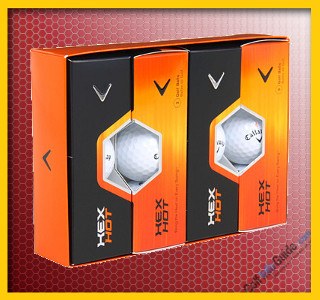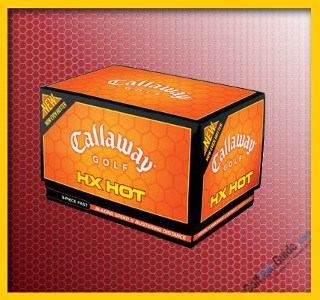
© Callaway Golf
Ball tested: Callaway HEX Hot
Category: Premium
Specs: Construction – Three-piece; Cover – Trionomer; Core – Trionomer; Dimples / Pattern – 332 in HEX (hexagonal) design
Compression: High
Price as tested (new): $26.99 per dozen
Ball notes: With the HEX Hot and HEX Hot Pro golf balls, Callaway takes dead aim at the niche occupied by the Bridgestone e6, Titleist Velocity and similar distance-first, spin-second models. As with the company’s entire 2013 lineup, it’s branded “HEX” in reference to the hexagonal dimples and their unique cover arrangement.
Golf Digest thinks highly of Callaway’s new offerings, awarding both the HEX Hot and HEX Hot Pro gold medals in 2013 Hot List rankings.
By the way, the HEX Hot is offered in optic yellow; the Hot Pro is not.

© Callaway Golf
Sound and feel: Callaway doesn’t promote the HEX Hot as a super-soft ball, which is a good thing. It’s not. Feel is definitely on the firm side – certainly compared with the Bridgestone e6. Players who like the HEX Hot’s performance but prefer a little more feel should check into its sibling, the softer HEX Hot Pro.
Off the tee: Now we’re talking. The HEX Hot does, indeed, pack some serious driver heat. We’ve been impressed not only with the distance of the HEX models, but the steady, penetrating flight, too. Perhaps Callaway is onto something with this geometrical dimple thing.
From the fairway / rough: While the HEX Hot feels just as firm with the irons, we noticed something that differentiates this ball from competitors: It’s actually pretty workable. Whereas most “premium” models are designed to curtail sidespin as much as possible, Callaway has managed to make a ball that responds when asked to fade or draw. Best of all, there’s no obvious loss of accuracy. Bravo, Callaway, bravo.
Around the green: The HEX Hot is a three-piece ball, which usually signifies ample greenside feel and spin. Yeah… not so much. Short game virtuosos may find it difficult to make this ball dance like some others, though we’d still rate the HEX Hot above your average “value/distance” ball in this department.
Bottom line: Whether it’s the dimples or some other technical feature, Callaway keeps cranking out balls that fly with beautiful stability while allowing shotmakers to work a little magic. The HEX Hot isn’t the softest or highest-spinning model out there, but its tee-to-green performance leaves little to be desired.
Golf Ball Videos:
– Compression Video
– Spin Video
– Dimples Video
– Golf Ball Brands Video
– Titleist Video
– Understanding Spin Video
Categories Explained:
Value/Recreational/Distance – Designed for mid- to high-handicap golfers with swing speeds below 90 mph; typically feature two-piece construction and firm covers; promote greater distance over high spin rates. Examples: Pinnacle Gold, Slazenger RAW Distance
Premium – Designed for low- to mid-handicap golfers with swing speeds of 90-99 mph; typically feature multi-layer construction and medium-soft covers; happy medium between Value/Recreational and Tour categories for distance and spin qualities. Examples: Titleist NXT Tour, Callaway HEX Diablo
Tour/Advanced/Performance – Designed for low-handicap and professional golfers with swing speeds in excess of 100 mph; typically feature multi-layer construction and soft covers; promote greater spin rates and enhanced feel over distance. Examples: Titleist ProV1, Bridgestone Tour B330





